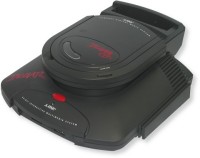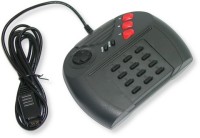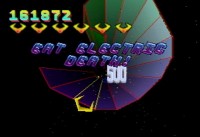 |
In 1991, the Sega Genesis was at the cutting edge of videogame technology in America and enjoying strong sales. NEC's Turbografx-16 was a distant second, and the Super Nintendo was yet to be released. Rumors swirled about various new peripherals and consoles - Genesis and Neo-Geo CD drives, the Sony Playstation, and a CD drive for the forthcoming Super Nintendo. Another rumor to circulate in 1991 was that Atari was back with a new 32-bit console called the Panther that was set to debut against the Super Nintendo later that year. However, after the Summer CES that year, Atari announced that the Panther was cancelled so that they could concentrate on a new machine, the 64-bit Jaguar. Behind the scenes, Atari had actually been developing both systems at the same time, but the Jaguar had progressed at such a rate that it made sense to skip the Panther.
Atari was very tight-lipped about its new machine at first, but then it began sending out press releases announcing the Jaguar with various technical specifications. Atari said they planned to debut the machine in 1993, and that there would definitely be a 64-bit RISC based processor at its core. This was exciting news to gamers, as it would seemingly make it the most technically advanced machine, well beyond the 16-bit Sega Genesis and Super Nintendo. Even better, Atari said the price would be between $100 and $150.
 |
Technically, the Jaguar was impressive. Five processors reside in three chips, two of them being proprietary (Tom and Jerry) with a third being a Motorola 68000 coprocessor. The GPU runs at 26.591Mhz and is rated at 26.591 MIPS (Millions of Instructions Per Second). There is a 64-bit data bus for communication and two megabytes of fast-page mode DRAM. Development systems cost between $7,500 and $9,000 and ran on IBM PC or Atari TT030 computers, with art development possible on various other machines.
When Atari finally announced the official launch of the Jaguar, the price tag was $200 and was bundled with a Cybermorph cartridge and one controller. However, when it actually hit store shelves the price had climbed to $250. Even with a higher price tag, sales were brisk. IBM was manufacturing the system for Atari, and things were looking up. Atari was set to market the Jaguar with a $3 million advertising budget, a telephone support line, and promised support from over 20 third party developers. However, retailers and the media were still skeptical that Atari could deliver quality software and keep all of its promises.
When the machine actually hit the streets, the reaction was mixed. Some gamers were excited by the increased power, while some felt that the system fell short of its promises. Some people claimed that the the Jaguar wasn't actually a true 64-bit system, that it was simply two 32-bit processors working in parallel. However, Atari was pressing forward with their advertising campaign touting its 64-bit power, and an impressive number of third-party titles had been announced in development. Unfortunately for these developers, the Jaguar proved very difficult to program for and Atari did not have sufficient development tools. Many Jaguar games were consequently delayed, and others were rushed out the door and were less than impressive. Ultimately, many announced developers simply did not develop any Jaguar titles.
 |
The Jaguar's first game was the system pack-in, Cybermorph. Although an impressive polygonal game for its time, Cybermorph still received its share of criticism for design flaws and a weak color palette. The second title, Trevor McFur in the Crescent Galaxy, was criticized by the media and even accused of being a glorified demo. This was followed by Raiden and Dino Dudes, which were also poorly received and gamers remarked that they looked like 16-bit games. Atari's first hit came in the form of Jeff Minter's Tempest 2000, an update to the classic game that was almost universally applauded and won several awards. This was followed by Doom, Wolfenstein 3D, and Alien vs. Predator, the latter being one of the best selling Jaguar games ever. Then Atari won several out-of-court settlements with Nintendo and Sega over patent infringements, totaling around $70 million dollars. Things were looking better, but the damage may have been done.
Christmas of 1994 was very important to Atari, but unfortunately it was a weak holiday season for videogames in general. Lackluster titles such as Checkered Flag, Kasumi Ninja, and Club Drive didn't help. The Sega Saturn was lurking on the horizon, and gamers seemed content to spend money on their Sega Genesis and Super Nintendo systems instead of buying a Jaguar. In late 1995, the Sega Saturn and Sony Playstation were released in the U.S., and fans quickly forgot about Atari's machine. Even though it claimed to be superior in processing power (64-bit vs. 32-bit), that now seemed either inaccurate or irrelevant given the demonstrations by Sony and Sega's new consoles. Atari wasn't giving up however, and they announced the release of their CD-ROM attachment, Pro Controller, and some marquee titles like Primal Rage and NBA Jam Tournament Edition.
After the Christmas 1995 shopping season, it was apparent that Atari would not be able to compete. Sony's Playstation was the clear winner, and Atari admitted it had sold only $3 million worth of Jaguar merchandise in the last quarter of 1995. Although Atari stated it would continue to support the Jaguar, they began laying off staff and moved to smaller accommodations. Then Atari announced that they would be merging with hardware manufacturer JTS and discontinuing all support of the Jaguar. In early 1996, they released the last Jaguar title, Fight For Life, and almost all remaining Atari employees were laid off.
 |
Before the collapse, Atari had actually been developing the Jaguar II and even assembled some prototypes. It was going to be fully backwards compatible with the Jaguar, and the processing power was said to be two to three times that of the Sony Playstation. There were to be seven processors on three chips, with the fastest processor running at 53Mhz. Unfortunately, the Jaguar II never made it beyond the prototype stage so we'll never know what it might have been capable of.
Time Warner had also licensed the Jaguar architecture for the arcades, where it was known as the "CoJag". These systems were basically Jaguar chipsets with extra memory and some other enhancements, and resulted in the arcade games Area 51, Maximum Force, and an unreleased puzzle game called Freeze. Stock Jaguars were also used as controllers for several kiddie ride games such as Skycopter II, Speedster II, and Spaceguy. These kiddie rides were going to be deployed outside of stores such as K-Mart, various supermarkets, and Chuck E. Cheese.
The Jaguar may have been dead to corporate America and the general gaming
public, but not to everyone. Texas-based Telegames
published several unreleased games beginning in 1996, including Breakout
2000, Towers
II, Worms,
Zero
5, Iron
Soldier II and World
Tour Racing. A company called ICD
published Air
Cars (the first 8-player linkable Jaguar game) and the Cat
Box networking device. Carl Forhan's Songbird
Productions continues to program and publish Jaguar games, and has
already released Protector,
Hyperforce,
Skyhammer,
and Soccer
Kid. 4Play
released BattleSphere,
a long-awaited and well received polygonal space combat game. Hasbro also
dropped the licensing fees
for new Jaguar titles, opening up the scene for even more development.
There are also dozens of prototype games that were never released and
have yet to surface to the public. You haven't seen the last of the Jaguar
yet.